Feedback & Regression
Contents
19. Feedback & Regression#
import numpy as np
import seaborn as sns
import matplotlib.pyplot as plt
from sklearn import datasets, linear_model
from sklearn.metrics import mean_squared_error, r2_score
from sklearn.model_selection import train_test_split
import pandas as pd
sns.set_theme(font_scale=2,palette='colorblind')
data_url = 'https://raw.githubusercontent.com/rhodyprog4ds/rhodyds/main/data/310_data_22-midsem.csv'
19.1. Feedback from you#
Here is the feedback from the survey that you completed with feedback on the course.
feedback_df_raw = pd.read_csv(data_url)
feedback_df_raw.head()
| How much do you think you've learned so far this semester? | How much of the material that's been taught do you feel you understand? | How do you think the achievements you've earned so far align with your understanding? | Rank the following as what you feel the grading (when you do/not earn achievements) so far actually reflects about your performance in the class [How well I follow instructions] | Rank the following as what you feel the grading (when you do/not earn achievements) so far actually reflects about your performance in the class [What I understand about the material] | Rank the following as what you feel the grading (when you do/not earn achievements) so far actually reflects about your performance in the class [How much effort I put into assignments] | How fair do you think the amount each of the following is reflected in the grading [How well I follow instructions] | How fair do you think the amount each of the following is reflected in the grading [What I understand about the material] | How fair do you think the amount each of the following is reflected in the grading [How much effort I put into assignments] | Which of the following have you done to support your learning outside of class time? | |
|---|---|---|---|---|---|---|---|---|---|---|
| 0 | 4 | 4 | I think they reflect my understanding well | Reflected perfectly in the grading | Reflected perfectly in the grading | Reflected perfectly in the grading | Is fairly reflected in the grading | Is fairly reflected in the grading | Is fairly reflected in the grading | read the notes online, experimenting with the ... |
| 1 | 5 | 4 | I think they reflect my understanding well | Reflected perfectly in the grading | Reflected perfectly in the grading | Reflected perfectly in the grading | Is fairly reflected in the grading | Is fairly reflected in the grading | Is fairly reflected in the grading | read the notes online, experimenting with the ... |
| 2 | 3 | 3 | I think they reflect my understanding well | Reflected moderately in the grading | Reflected moderately in the grading | Reflected moderately in the grading | Should be less reflected in the grading | Is fairly reflected in the grading | Is fairly reflected in the grading | read the notes online, download and run the no... |
| 3 | 4 | 3 | I think they reflect my understanding well | Reflected moderately in the grading | Reflected moderately in the grading | Reflected moderately in the grading | Is fairly reflected in the grading | Is fairly reflected in the grading | Is fairly reflected in the grading | read the notes online, reading the documentati... |
| 4 | 5 | 2 | I think they reflect my understanding well | Reflected moderately in the grading | Reflected strongly in the grading | Reflected a little in the grading | Is fairly reflected in the grading | Is fairly reflected in the grading | Should be reflected more in the grading | read the notes online, experimenting with the ... |
feedback_df_raw.columns
Index(['How much do you think you've learned so far this semester?',
'How much of the material that's been taught do you feel you understand?',
'How do you think the achievements you've earned so far align with your understanding?',
'Rank the following as what you feel the grading (when you do/not earn achievements) so far actually reflects about your performance in the class [How well I follow instructions]',
'Rank the following as what you feel the grading (when you do/not earn achievements) so far actually reflects about your performance in the class [What I understand about the material]',
'Rank the following as what you feel the grading (when you do/not earn achievements) so far actually reflects about your performance in the class [How much effort I put into assignments]',
'How fair do you think the amount each of the following is reflected in the grading [How well I follow instructions]',
'How fair do you think the amount each of the following is reflected in the grading [What I understand about the material]',
'How fair do you think the amount each of the following is reflected in the grading [How much effort I put into assignments]',
'Which of the following have you done to support your learning outside of class time? '],
dtype='object')
short_names = {"How much do you think you've learned so far this semester?":'learned',
"How much of the material that's been taught do you feel you understand?":'understand',
"How do you think the achievements you've earned so far align with your understanding?":'achievements',
'Rank the following as what you feel the grading (when you do/not earn achievements) so far actually reflects about your performance in the class [How well I follow instructions]':'grading_instructions',
'Rank the following as what you feel the grading (when you do/not earn achievements) so far actually reflects about your performance in the class [What I understand about the material]':'grading_understanding',
'Rank the following as what you feel the grading (when you do/not earn achievements) so far actually reflects about your performance in the class [How much effort I put into assignments]':'grading_effort',
'How fair do you think the amount each of the following is reflected in the grading [How well I follow instructions]':'fairness_instructions',
'How fair do you think the amount each of the following is reflected in the grading [What I understand about the material]':'fairness_understanding',
'How fair do you think the amount each of the following is reflected in the grading [How much effort I put into assignments]':'fairness_effort',
'Which of the following have you done to support your learning outside of class time? ':'learning_activities'}
feedback_df_cols = feedback_df_raw.rename(columns=short_names)
feedback_df_cols.head(2)
| learned | understand | achievements | grading_instructions | grading_understanding | grading_effort | fairness_instructions | fairness_understanding | fairness_effort | learning_activities | |
|---|---|---|---|---|---|---|---|---|---|---|
| 0 | 4 | 4 | I think they reflect my understanding well | Reflected perfectly in the grading | Reflected perfectly in the grading | Reflected perfectly in the grading | Is fairly reflected in the grading | Is fairly reflected in the grading | Is fairly reflected in the grading | read the notes online, experimenting with the ... |
| 1 | 5 | 4 | I think they reflect my understanding well | Reflected perfectly in the grading | Reflected perfectly in the grading | Reflected perfectly in the grading | Is fairly reflected in the grading | Is fairly reflected in the grading | Is fairly reflected in the grading | read the notes online, experimenting with the ... |
learning_lists = feedback_df_cols['learning_activities'].str.split(',')
learning_stacked = learning_lists.apply(pd.Series).stack()
learning_df = pd.get_dummies(learning_stacked).sum(level=0)
learning_df.head()
/tmp/ipykernel_2356/3116911913.py:3: FutureWarning: Using the level keyword in DataFrame and Series aggregations is deprecated and will be removed in a future version. Use groupby instead. df.sum(level=1) should use df.groupby(level=1).sum().
learning_df = pd.get_dummies(learning_stacked).sum(level=0)
| attended Aiden's office hours | attended Dr. Brown's office hours | download and run the notes | experimenting with the code from class | reading blogs or tutorials I find on my own | reading the documentation or course text | tinkering with code to answer other aspects of the material that I'm curious about | update the notes I took during class time | watching videos that I find on my own | download and run the notes | read the notes online | update the notes I took during class time | |
|---|---|---|---|---|---|---|---|---|---|---|---|---|
| 0 | 0 | 0 | 0 | 1 | 1 | 0 | 0 | 0 | 1 | 0 | 1 | 0 |
| 1 | 0 | 0 | 0 | 1 | 0 | 1 | 1 | 0 | 0 | 0 | 1 | 0 |
| 2 | 0 | 1 | 1 | 1 | 0 | 0 | 0 | 1 | 0 | 0 | 1 | 0 |
| 3 | 1 | 1 | 0 | 0 | 0 | 1 | 1 | 0 | 0 | 0 | 1 | 0 |
| 4 | 1 | 0 | 0 | 1 | 1 | 1 | 0 | 0 | 1 | 0 | 1 | 0 |
learning_df.sum()
attended Aiden's office hours 7
attended Dr. Brown's office hours 4
download and run the notes 4
experimenting with the code from class 11
reading blogs or tutorials I find on my own 9
reading the documentation or course text 11
tinkering with code to answer other aspects of the material that I'm curious about 5
update the notes I took during class time 4
watching videos that I find on my own 7
download and run the notes 1
read the notes online 13
update the notes I took during class time 1
dtype: int64
el_meaning = {1: 'much less',
2: 'a little less',
3: 'about right',
4: 'a little more ',
5: 'much more'}
question_text = list(short_names.keys())[list(short_names.values()).index('learned')]
el_counts,_ = np.histogram(feedback_df_cols['learned'],bins = [i+.5 for i in range(6)])
el_df = pd.DataFrame(data = el_counts,index = el_meaning.values(),columns= [question_text],)
# el_df.rename_axis(index='amount relative to expectations',inplace=True)
el_df.plot.bar(legend=False);
# sns.displot(feedback_df['learned'].replace(el_meaning))
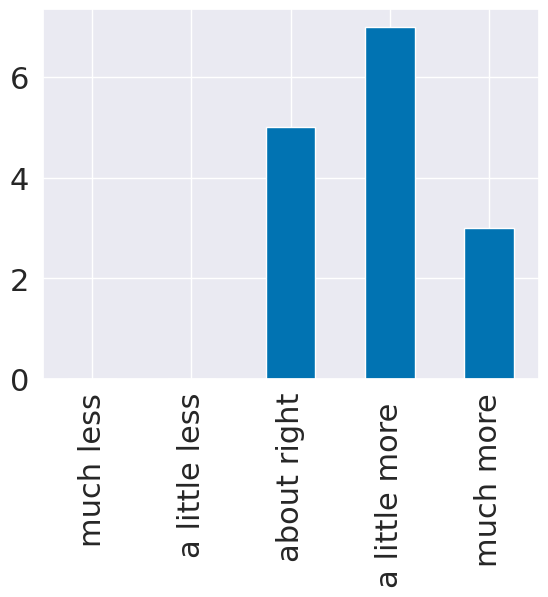
u_meaning = {0:'None', 1:'A little',3:'A moderate amount', 4:'Almost all',5:'All'}
question_text = list(short_names.keys())[list(short_names.values()).index('understand')]
u_counts,_ = np.histogram(feedback_df_cols['understand'],bins = [i+.5 for i in range(6)])
u_df = pd.DataFrame(data = el_counts,index = u_meaning.values(),columns= [question_text],)
u_df.plot.bar(legend=False);
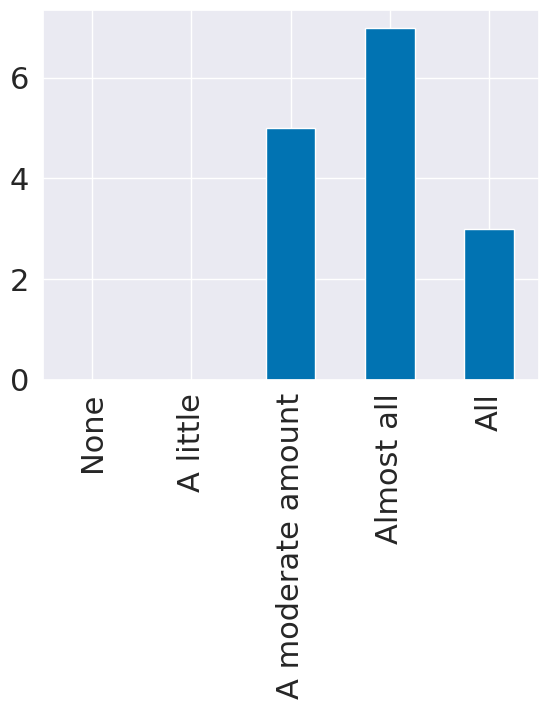
20. Responses to Qualitative Comments#
Going forward, the assignments are more tied together so you do not need to find as many datasets. I’ve made myself a note to go back and update A1-A5 for next year.
help by contributing do not use list to course website
I will try to make sure that most code is prepared so I can send on prismia
I recommend aligning your prismia & notebook side by side. (I cannot model this because of font size limitations)
I’ve requested for longer blocks for next fall… but classroom availability (this is a good idea!)
20.1. Regression#
We’re going to predict tip from total bill using 80% of the data for training. This is a regression problem because the target, tip is a continuous value, the problems we’ve seen so far were all classification, species of iris and the character in that corners data were both categorical.
Using linear regression is also a good choice because it makes sense that the tip would be approximately linearly related to the total bill, most people pick some percentage of the total bill. If we our prior knowledge was that people typically tipped with some more complicated function, this would not be a good model.
tips_df = sns.load_dataset("tips")
tips_df.head()
| total_bill | tip | sex | smoker | day | time | size | |
|---|---|---|---|---|---|---|---|
| 0 | 16.99 | 1.01 | Female | No | Sun | Dinner | 2 |
| 1 | 10.34 | 1.66 | Male | No | Sun | Dinner | 3 |
| 2 | 21.01 | 3.50 | Male | No | Sun | Dinner | 3 |
| 3 | 23.68 | 3.31 | Male | No | Sun | Dinner | 2 |
| 4 | 24.59 | 3.61 | Female | No | Sun | Dinner | 4 |
Split the data so that we use 80% of the data to train a modle to predict the tip from the total bill
tips_X = tips_df['total_bill'].values
tips_X = tips_X[:,np.newaxis] # add an axis
tips_y = tips_df['tip']
tips_X_train,tips_X_test, tips_y_train, tips_y_test = train_test_split(tips_X,tips_y,train_size=.8)
To see what that new bit of code did, we can examine the shapes:
tips_X.shape
(244, 1)
what we ended up is 2 dimensions (there are two numbers) even though the second one is 1.
tips_df['total_bill'].values.shape
(244,)
this, without the newaxis is one dimension, we can see that because there is
no number after the comma.
Now that our data is ready, we create the linear regression estimator object
regr = linear_model.LinearRegression()
type(regr)
sklearn.linear_model._base.LinearRegression
Now we fit the model.
regr.fit(tips_X_train,tips_y_train)
LinearRegression()In a Jupyter environment, please rerun this cell to show the HTML representation or trust the notebook.
On GitHub, the HTML representation is unable to render, please try loading this page with nbviewer.org.
LinearRegression()
We can examine the coefficients and intercept.
regr.coef_, regr.intercept_
(array([0.10123819]), 0.9629915620718386)
These define a line (y = mx+b) coef is the slope.
Important
This is what our model predicts the tip will be based on the past data. It is important to note that this is not what the tip should be by any sort of virtues. For example, a typical normative rule for tipping is to tip 15% or 20%. the model we learned, from this data, however is ~%10 + \(1. (it's actually 9.68% + \)1.028)
To interpret this, we can apply it for a single value. We trained this to predict the tip from the total bill. So, we can put in any value that’s a plausible total bill and get the predicted tip.
We can predict the data
tips_y_pred = regr.predict(tips_X_test)
type(tips_y_pred)
numpy.ndarray
To visualize in more detail, we’ll plot the data as black points and the predictions as blue points. To highlight that this is a perfectly linear prediction, we’ll also add a line for the prediction.
plt.scatter(tips_X_test,tips_y_test, color='black')
plt.scatter(tips_X_test,tips_y_pred, color='blue')
<matplotlib.collections.PathCollection at 0x7fdc93c34190>
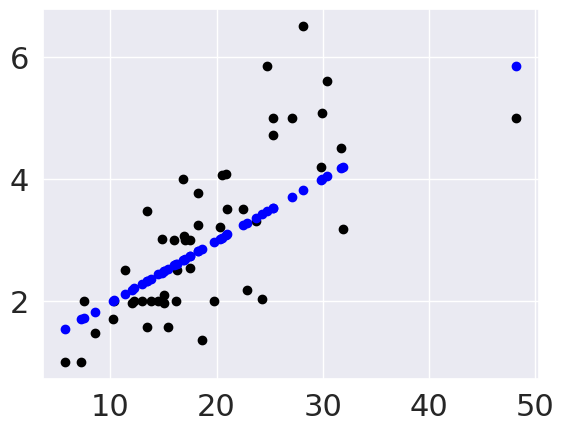
``
20.2. Evaluating Regression - Mean Squared Error#
From the plot, we can see that there is some error for each point, so accuracy that we’ve been using, won’t work. One idea is to look at how much error there is in each prediction, we can look at that visually first.
These red lines are the residuals.
plt.scatter(tips_X_test, tips_y_test, color='black')
plt.plot(tips_X_test, tips_y_pred, color='blue', linewidth=3)
# draw vertical lines frome each data point to its predict value
[plt.plot([x,x],[yp,yt], color='red', linewidth=3)
for x, yp, yt in zip(tips_X_test, tips_y_pred,tips_y_test)];
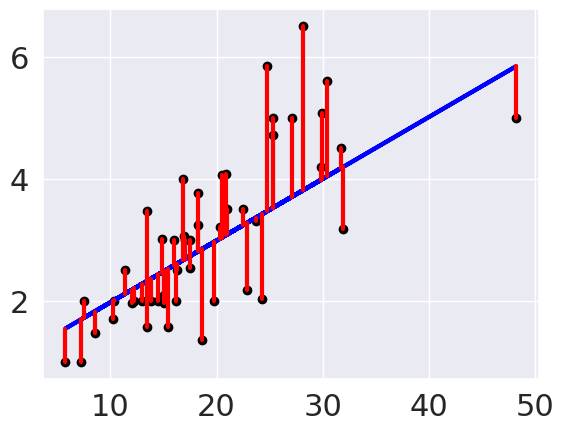
We can use the average length of these red lines to capture the error. To get the length, we can take the difference between the prediction and the data for each point. Some would be positive and others negative, so we will square each one then take the average.
mean_squared_error(tips_y_test,tips_y_pred)
0.8421650416284583
We can get back to the units being dollars, by taking the square root.
np.sqrt(mean_squared_error(tips_y_test, tips_y_pred))
0.9176955059432613
This is equivalent to using absolute value instead
np.mean(np.abs(tips_y_test - tips_y_pred))
0.7208537516784601
20.3. Evaluating Regression - R2#
We can also use the \(R^2\) score, the coefficient of determination.
If we have the following:
\(n\) `=len(y_test)``
\(y\)
=y_test\(y_i\)
=y_test[i]\(\hat{y}\) =
y_pred\(\bar{y} = \frac{1}{n}\sum_{i=0}^n y_i\) =
sum(y_test)/len(y_test)
r2_score(tips_y_test, tips_y_pred)
0.5244799162296381
This is a bit harder to interpret, but we can use some additional plots to visualize. This code simulates data by randomly picking 20 points, spreading them out and makes the “predicted” y values by picking a slope of 3. Then I simulated various levels of noise, by sampling noise and multiplying the same noise vector by different scales and adding all of those to a data frame with the column name the r score for if that column of target values was the truth.
Then I added some columns of y values that were with different slopes and different functions of x. These all have the small amount of noise.
x = 10*np.random.random(20)
y_pred = 3*x
ex_df = pd.DataFrame(data = x,columns = ['x'])
ex_df['y_pred'] = y_pred
n_levels = range(1,18,2)
noise = (np.random.random(20)-.5)*2
for n in n_levels:
y_true = y_pred + n* noise
ex_df['r2 = '+ str(np.round(r2_score(y_pred,y_true),3))] = y_true
f_x_list = [2*x,3.5*x,.5*x**2, .03*x**3, 10*np.sin(x)+x*3,3*np.log(x**2)]
for fx in f_x_list:
y_true = fx + noise
ex_df['r2 = '+ str(np.round(r2_score(y_pred,y_true),3))] = y_true
xy_df = ex_df.melt(id_vars=['x','y_pred'],var_name='rscore',value_name='y')
# sns.lmplot(x='x',y='y', data = xy_df,col='rscore',col_wrap=3,)
g = sns.FacetGrid(data = xy_df,col='rscore',col_wrap=3,aspect=1.5,height=3)
g.map(plt.plot, 'x','y_pred',color='k')
g.map(sns.scatterplot, "x", "y",)
<seaborn.axisgrid.FacetGrid at 0x7fdc93b0e5e0>
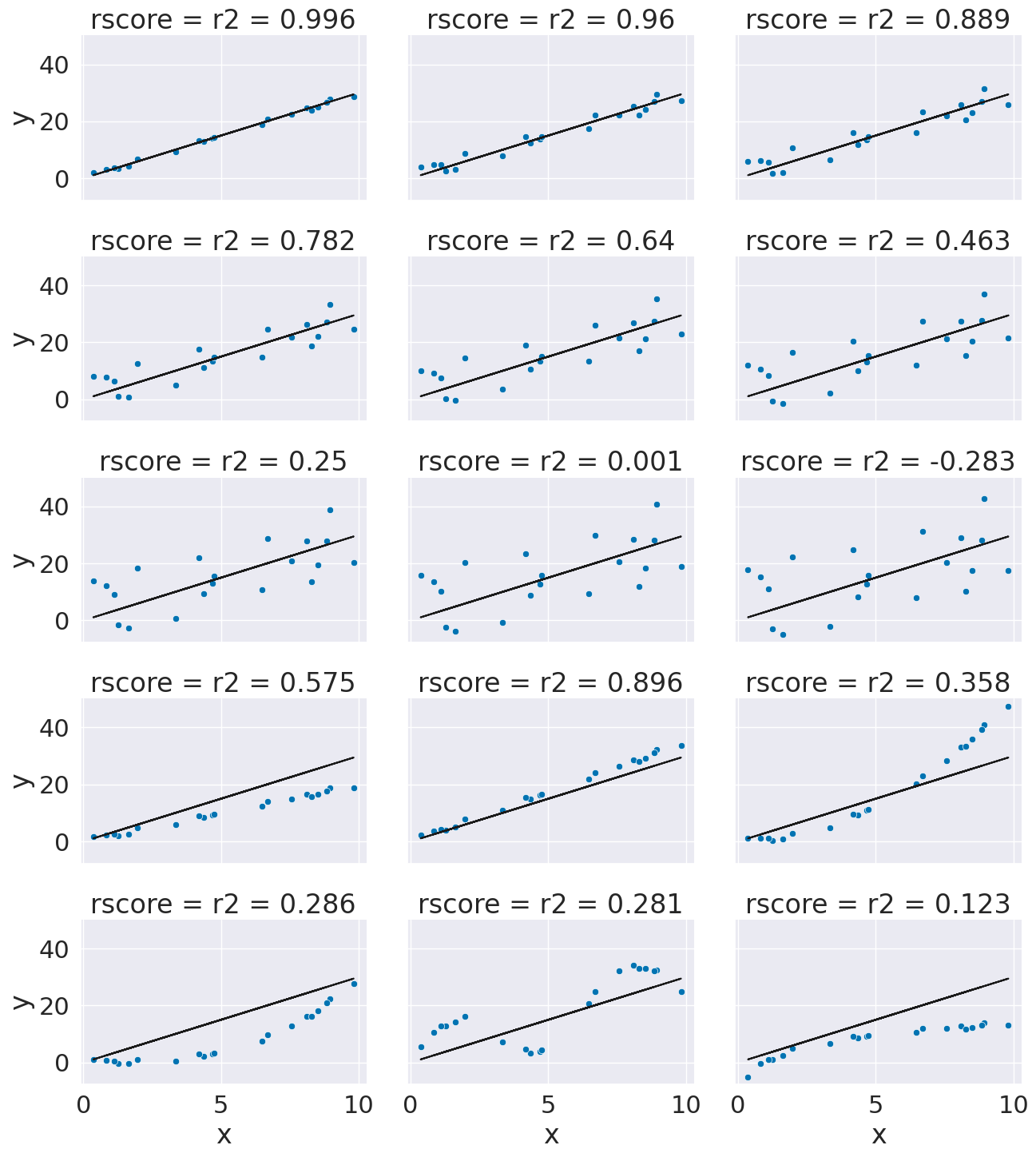
By default, the regression estimator uses the R2 score.
regr.score(tips_X_test,tips_y_test)
0.5244799162296381

